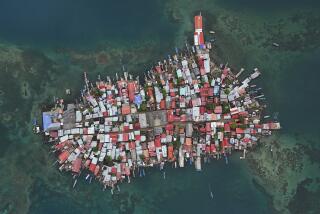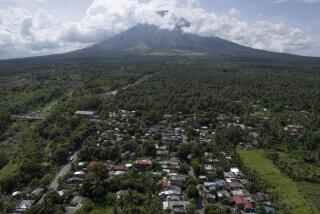UNDER THE VOLCANO : As Mt. Pinatubo Continues to Spew Tons of Ash and Rock, Filipinos Wonder How Their Battered Country Will Ever Recover
- Share via
It is a surreal scene.
For mile after mile along the Philippines’ South China Sea coast, a thick blanket of ash has choked rivers and streams, crushed tall trees and homes and buried fertile fields and steep hills alike in a deathly shroud of gray. Cats, cars and clothes all bear the same chalky pallor.
Under a harsh sun, ash glistens like snow on distant mountains. Suddenly, a towering plume of steam and smoke billows skyward, spewing more gray grit across the once green plains of central Luzon. It is another minor eruption from the volcano that has changed the Philippines forever.
At a hillside cluster of tattered thatch huts outside Botolon, once a thriving coastal town, 1,487 refugees occupy one of scores of squalid camps set up after Mt. Pinatubo exploded June 15--one of the most violent volcanic eruptions in the world in the past 200 years.
Edward Santos, one of about 30,000 Aeta aboriginal tribesmen evacuated from the slopes of Mt. Pinatubo, says geothermal drilling on the mountain angered Apo Namalyari, the Aeta god of the volcano. Worse, the government geologists refused to sacrifice a young goat to appease the volcano god. Hence, the sky fell in.
“We tell them, but they do not hear,” the four-foot-tall, bearded Aeta explains patiently, as if to a child. “These people are digging and anger the mountain. So we must run away. And now our people are lost.”
Much of the Philippines seems sadly lost under the volcano these days. A staggering series of eruptions, earthquakes and mudslides has left about 400 people dead and an estimated 250,000 homeless and caused more than $1 billion in damage--less than a year after a devastating earthquake and typhoon.
Mt. Pinatubo’s eruption, like those of most Pacific Rim volcanoes, resulted from centuries of slow, steady buildup of pressure. When it blew its top, leaving a two-mile-wide crater, the released pressure shot steam and gas 15 miles high and disgorged an estimated 2 billion tons of pumice, rocks and ash. Experts believe that eruptions could continue for several years.
Now, clouds of Pinatubo ash circle the globe, causing kaleidoscopic sunsets from Miami to Melbourne. Volcanoes can affect climate in ways not yet fully understood; some scientists suggest that even this single eruption may reduce global warming by filtering the sun’s intensity. And in a decade or two, volcanic deposits may enrich Philippine soil with elements leached away by tropical rains.
But that’s the future. Now, President Corazon Aquino’s government is overwhelmed by broken bridges, buried homes and lost crops. The United States has sent 20,000 troops and dependents home, abandoning its crippled Clark Air Base. The move will eliminate the jobs of 40,000 Filipinos and cut off hundreds of millions of dollars that the Pentagon pumps into the economy.
Moreover, tens of thousands of Filipinos, part of what officials call the largest evacuation ever caused by a volcano, face an uncertain future living in miserable tent camps, schools and stadiums. The Aetas, in particular, may lose their animist culture, long hidden in Pinatubo’s deep forests. Many are eating canned food, riding in trucks and trading loincloths for trousers for the first time.
Nor is the danger over. Driving monsoon rains have begun to trigger fast-moving monster mudflows called lahars. The mud has the consistency of liquid concrete and roars down steep slopes, overflows riverbeds and entombs entire towns. Mud, sand and gravel already have buried parts of Botolon, and a third of the 35,000 residents have fled, many to 16 camps and evacuation centers perched on high ground in nearby mountains.
Still, there appears little sense of urgency. Botolon’s mayor, Tito B. Doble, says the mouth of the Bucau River, which flows through town, is clogged. He’s asked Manila for bulldozers to clear the channel to prevent further flooding, but none has arrived.
So he’s prepared a warning-and-evacuation plan. Two policemen are stationed upstream with orders to radio him if a flood or lahar approaches. I ask if he has a radio to get the message. “As of this moment, none yet,” he says after a pause. “That is my problem.”
Assuming warning does come, Doble says he will shoot fireworks to alert the populace. “One rocket means get ready,” he explains. “Two rockets, get set. And three rockets, you go, go, go!” He grins broadly.
There are other problems. Manila sent 10,000 rice sacks so Botolon residents could make sandbags from the ash to build dikes along the river. But the bags were meant for rice. Fully packed with ash, each weighs 220 pounds.
“You need a bulldozer to lift it,” Doble says. “And we have no bulldozer.” So dikes are unbuilt.
Ash, sand and mud have fouled wells and water supplies. Electricity and phones are out, idling factories and businesses. Lucrative prawn farms, coconut plantations and sugar-cane farms are ruined. All told, the government estimates 600,000 people have lost their livelihoods.
It is one reason why President Aquino has encouraged people to make bricks and souvenirs from the ash. Acting on her instructions, Philippine consulates now offer half-pint jars full of Pinatubo ash and sand to people who donate $10 or more for rehabilitation and relief projects. “It’s not a total loss,” explains Aquino’s spokesman, Tomas Gomez. “Somehow, somewhere in the world, we’ll find a use.” He adds: “I’m sure detractors will make fun of us.”
At a school in Floridablanca, 10 miles south of the volcano, 1,063 mostly Aeta evacuees are crammed into four sweltering classrooms and 74 yellow tents. Flies swarm around naked children as pigs root through heaps of garbage. A few women cook rations of rice and canned pork and beans on open fires.
But many families sit silently under the broiling tents, staring out at the thick dust. “People are thinking how to survive,” says 72-year-old Amado Dison, who lost his home. “What if the eruptions go on for three years?”
Dr. Fernando Igrobay, who has treated hundreds of Aetas for respiratory infections and diarrhea, says life here will never be the same. “What will happen to them? It’s GOK: God Only Knows.”
More to Read
Sign up for Essential California
The most important California stories and recommendations in your inbox every morning.
You may occasionally receive promotional content from the Los Angeles Times.











